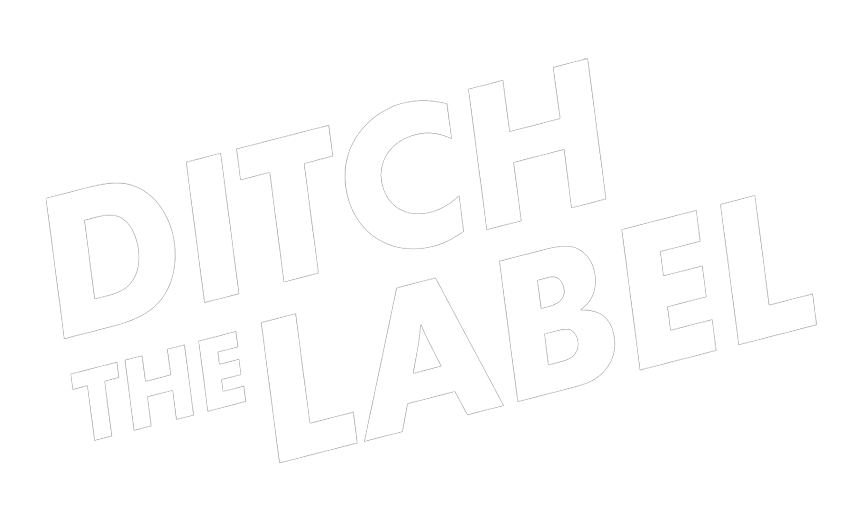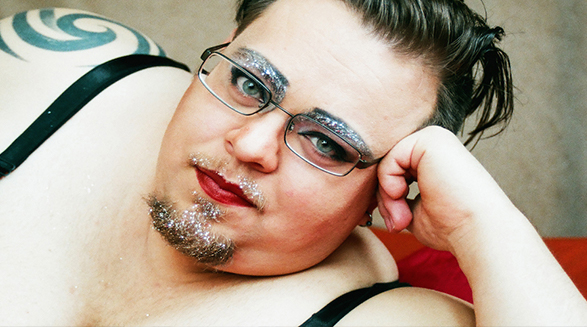“Gender is not sane. It’s not sane to call a rainbow black and white” – Kate Bornstein (American author and gender theorist)
Gender As a Spectrum is a book that challenges the notion of gender binaries and explores the lives of trans and genderqueer people in an intimate series of photographs and interviews. We spoke to photographer Joseph Wolfgang Ohlert and co-author Kaey to find out more about the inspiration behind the book and what it means to be trans and genderqueer in 2016.
DtL: How did the idea for the book come about?
Joseph: A mutual friend introduced us. That was also the evening I photographed Kaey for the first time.
Kaey: I already knew who Joseph was and what he did, though. Back then I was working for a fashion magazine in Hamburg, I was already aware of him and his work. I‘d basically followed him from the beginning. That was about three or four years ago. I‘d wanted for a while to make a book about transgender people and wrote to Joseph about it. He already had a similar idea, and had already started on a project.
Joseph: I was sick of just model boys and model photography and wanted to start something a little more personal. During my time at high school I elected to take an art course with the name ‘Man, Woman and Individuality’, and I wanted to pick up on that again. I was out on the scene a lot and wanted to do something for the community, something which I felt was missing, something that I could make comprehensible in my pictures. When Kaey wrote to me, I was in the middle of my preparations for my final paper at the Ostkreuz School of Photography in Berlin. I’d already been dealing with gender for that, and our ideas fitted together well.
“There are more than just ‘men’ and ‘women’”
Kaey: Three years ago, not long before I started taking hormones, I had a phase in which I had a very strong urge to read some literature about it. I noticed there was nothing available, or just nonsense. It was absurd that there was nothing which reflected my reality, and that of many of my transgender friends. I felt that something was missing and I imagined what I would like to find. I wanted to portray people in their differences, their own identities, their personal pathways and their own words. Not written by some author conveying a story. Not from reporters or non-trans people who had written a book, but transgender people writing about transgender people. I think it‘s nicer to speak up for yourself.
[full-width-figure image=”https://dtl-staging.org/2020/wp-content/uploads/2016/10/joseph_wolfgang_ohlert_1.jpg”]
DtL: The theme of gender identity is a sensitive and intimate issue for many; how did you approach the subjects and the interviews?
Kaey: From the get-go it was clear that the book and the topics should take the personal perspective. In practice, I decided because of that to conduct the interviews via email, so as to give people the time and personal space that they each needed. Sexuality and gender are often confused by many people and it was important to show that there are all kinds of genders, and that they also have all sorts of sexualities. That gender in and of itself doesn’t explain sexuality, but raises the question ‘how do I define myself and what I am into?’
“Sexuality and gender are often confused by many people”
Joseph: We wanted to have questions that were pretty intimate, but it was up to each person how they wanted to present themselves and which questions they wanted to answer. Some do it with humour and eloquence, without having to reveal their innermost selves. It was supposed to be a framework, so that people had the opportunity to say what was important to them.
Kaey: Ultimately, that opened up many dimensions for us; some portraits are very detailed, while others are very playful. Some respond succinctly, others put a lot of reflection into it. Although they are always the same questions, the variations in the answers made it very exciting.
DtL: Joseph – as a cis man, how did you arrive at the issue of gender, what relationship do you have to it?
Joseph: In Berlin you’re confronted with the fact that there are more than just ‘men’ and ‘women’, especially in the scene. Questions such as ‘who am I, and what makes me different from other people?’ arise. They’re thoughts which are fundamental to my understanding of human beings and how I deal with others. I always start with myself, with looking at myself objectively. The inequities between male/female, gay/straight, trans/cis – where are the boundaries, where do I locate myself in it and how can I disrupt it? I realised that there’s no fixed aspect of my gender and my sexuality that I could define as ‘me’, but that it is fluid. You can drift. You’re not trapped at any one point even if you, as I do, define yourself for example as a ‘man’. The book is therefore for me an analogy through which to understand life. Gender is a theme for everybody, and is part of every identity.
[full-width-figure image=”https://dtl-staging.org/2020/wp-content/uploads/2016/10/joseph_wolfgang_ohlert_21.jpg”]
DtL: The book doesn’t limit itself to one side of gender identity, but it contains portraits of people from transgender to drag, binary to non-binary, it also includes performed, playful aspects of gender roles. What was particularly important when selecting the subjects?
Kaey: In the beginning it was my idea to make a book about transgender people, but Joseph was very connected to the community around the drag scene, having taken a lot of pictures at parties. That is what captivated him. We wanted to then open the issue up and not confine ourselves to transgender themes. It also made sense for the title of the book, and the question of how people define their gender. The hook was to present people who do that differently to the norm.
Joseph: Maintaining a balance was difficult. A lot of the work was in persuasion. These are the real lives of the people whose portraits are presented here, and that’s sometimes a very profound thing. Suddenly people show up who want to show that to the world; something that intimate. This isn’t a scientific study for which we sought and collected, but a documentary collection of portraits of personal encounters. It was primarily always about the person and not necessarily about having to have a particular facet of gender represented. I didn’t want the work to take a back seat in order to keep everybody happy. The book was important to me, but it was also a lot of fun. I would like the people to feel the same joy when they look at the pictures that I felt when I took the images, and not to think about what could still be missing.
[full-width-figure image=”https://dtl-staging.org/2020/wp-content/uploads/2016/10/joseph_wolfgang_ohlert_18.jpg”]
DtL: For a while now, transgender issues have received the attention of the mainstream media. What is of particular personal importance to you about this new attention? Do you think your book could make a contribution to it?
Kaey: As a transgender woman I feel any visibility is important. When I was 18, there was no Internet, and what is possible today is worlds apart from that. Fortunately, there is now a limitless well of information if you‘re young and don’t know where you can, or want to position yourself. That well must continue to be filled, though. Transgender people and people who do not fit into standard categories still go too much ignored. It takes many voices, and it’s good that in the book there’s no Conchita Wurst or Caitlyn Jenner represented, people who get their press anyway. The average person, unfortunately, always hears more of the ‘shock stories’. It‘s great to have a book that just shows people as people, and I think that is still relatively rare for transgender people. When we give transgender people the opportunity to speak about themselves, it lends a whole new colour to the discussion. I know from personal experience that when cis people write about you, you’re always one of the very special butterflies behind glass – something to be admired before moving on to the next exhibit. When we speak for ourselves, I find it much more authentic.
“As a transgender woman I feel any visibility is important”
Joseph: Transgender has always been there, it’s not a new thing or a trend. Three or four years ago, when I started with this theme, there was no Caitlyn or Conchita in public
life. The increased attention was good for the work, though, and it has further convinced me that other people are interested in and being confronted by it. Due to the greater media attention, more people dare to stand up for themselves, and our work seeks to inspire people – that they can be who they are.
Kaey: I also find it important that it’s a book and not an exhibition. A book is something wonderful, something immortal! I would like to leave something for all those who come after me. Who do you have in Germany that talks about it? The book may be international, but in Germany we have far fewer icons like Caitlyn Jenner or Laverne Cox. Of course there are already conversations taking place about this topic in art contexts. The fact that we offered people the chance to tell their own stories themselves creates a great framework for discussion. Through Joseph’s eye an aesthetic is proposed which has nothing to do with bird-of-paradise readings, or representing people as sad freaks. Joseph has a flair for capturing people in their emotional presence. Not with a suffering gaze, but honestly. Sometimes melancholic…
Joseph: … and proud.
Kaey: Yes, proud too – it‘s a talent to capture emotions, whichever they may be.
Joseph: You can’t make a book on talent alone. Without Kaey this project would never have become what it is now. I am very glad that we found each other, with such a basic trust, and that something this valuable could come of it. We‘ve both grown through it. My photography has also evolved a lot over these two years. When you photograph someone, it is always a kind of convergence. It’s my desire to hold onto that – that interpersonal interaction of commitment that is created. As an artist, it is often as if that encounter would never have happened if I hadn’t taken a photo.
[full-width-figure image=”https://dtl-staging.org/2020/wp-content/uploads/2016/10/joseph_wolfgang_ohlert_4.jpg”]
Gender As a Spectrum is available from info@ohlert.de













